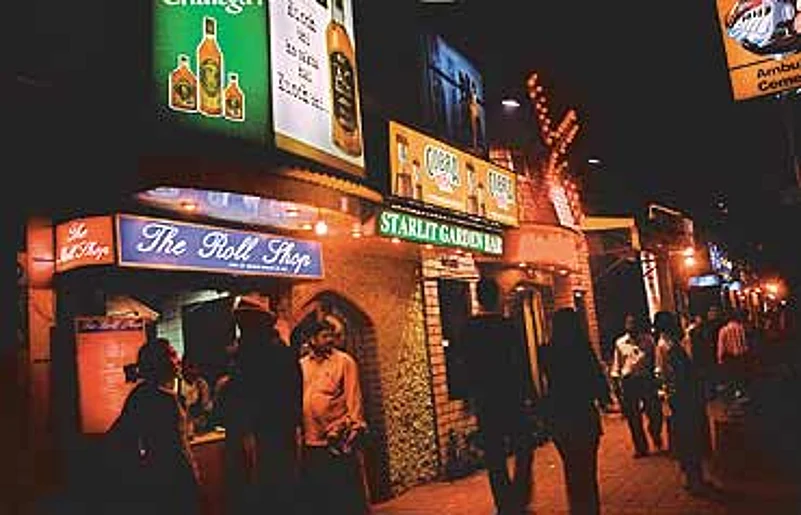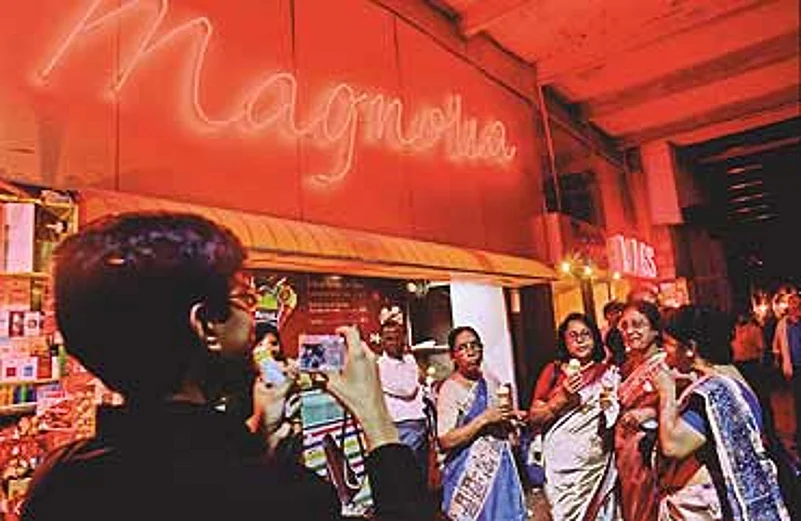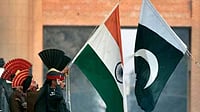- Naxal problems, Trade unionism
- Flight of capital and boxwallahs
- Departure of Anglo Indians, Armenians, Parsis
- CPI(M) government wooing capital
- More money to spend
- No moral policing
***

Park Street was where classy evening entertainment was born in India. "We had the first and best cabarets in the entire subcontinent. Crooners used to entertain diners at Mocambo, Trincas and Magnolia," said S.K. Khullar, owner of Amber restaurant and the president of the Hotel & Restaurant Association of Eastern India. Food critic Nondon Bagchi recalls that Usha Uthup and Biddu Appaya debuted at Trincas, and that Marie Samson (now Wilson), voted Australia's best jazz vocalist, once performed at a Park Street restaurant. VJ Luke Kenny's mother was a dancer at one of the restaurants. "At Blue Fox, Louis Banks, Pam Crain and Braz Gonsalves set evenings on fire. Crain debuted at Mocambo, which had a fancy glass dance floor with lights underneath," recalls Bagchi. Her signature song, Fire Down Below, became an international hit. Magnolia and Moulin Rouge were other popular nightspots, the latter boasting sizzling cabarets with Can-Can dancers.
Deepak Puri, one of the owners of Trincas, another legendary Park Street restaurant, also lives on Park Street, and has fond memories of those days when the road used to be washed every morning and gas lamps lit every evening. "The afternoons were for the youngsters flocking to Park Street, giving the place a carefree and exuberant air. Evenings were more stately with gleaming imported cars gliding down the street, carrying elegant and suave men and women to the restaurants. It was all so glorious," reminisces Puri. That was a time when Calcutta itself was a genteel and urbane city, strongly rooted in Raj traditions.
But Puri also recalls the decline caused by large-scale migration of Anglo-Indians, Parsis and other minority communities, the Naxalite violence of the '70s, militant trade unionism, the flight of capital, crippling power cuts and the all-pervasive fear that accompanied all the cataclysmic changes in the life of the city. Park Street's establishments reflected the decline starkly. "Since businesses ran away, so did our regular, affluent customers," says Puri.

Eateries that had once closed down are reopening
"It was a magnificent place until the '60s. Then came the dark period. Calcutta and Park Street lost a lot of what made them truly cosmopolitan—the Parsi, Armenian, Jewish and Anglo-Indian communities," agrees writer and Calcutta lover Bachi Karkaria. Mocambo, Park Street's first soda fountain and the hangout of Allied soldiers during World War II, closed down due to labour troubles. As did Moulin Rouge and Blue Fox.
The revival of Park Street, and Calcutta, began in 2003-04. "In the period from the late 1960s to 2004, just four new restaurants came up in the city. But over the past three years, 86 new restaurants have come up, many of them on Park Street," says Khullar. Customers, the restaurateurs say, are also spending much more. "There has been a sea change in business volumes over the past three years or so," says Puri.
Eagerly awaited is the rebirth of the legendary continental restaurant, Sky Room, after 15 long years with its shutters down. Eminent writer Mani Shankar Mukherjee recalls a time when companies headquartered in Calcutta (and indeed, most of them were, then) refused to hold their board meetings on a Tuesday since the Sky Room used to be closed that day! The new Sky Room promises a more modern look, but continues to dish out the fare that made it famous. Like the prawn cocktails that Indira Gandhi used to have flown to Delhi.

Even the middle-aged are game for an ice cream on Park Street
But, reflecting on the changes that have swept the city, the demographic and social profile of diners will be very different. "Our customers were the executives of big companies and the landed gentry. They formed a nice potpourri of communities and cultures. Today, we get businessmen, traders and a fair sprinkling of marketing executives. Nearly all are Marwaris or Bengalis," says Trincas' Puri. Adds Kothari: "The customers are casual in attire and attitude as compared to our patrons of the past. That's how Calcutta has also changed from the 1960s into a more egalitarian place."
Yet some things have not changed about this street. "Park Street remains the place where you can relax completely, be yourself and party till the small hours, without anyone bothering you," says Bagchi. "No rowdyism and no moral policing like other Indian cities. Show me one place like Someplace Else (the pub at Park Hotel) anywhere in the country that has ten bands performing throughout the week. It's the Mecca for musicians from around the country." Exults Bachi Karkaria, "Park Street is what makes Calcutta a living city. It's iconic. I can't think of any street in any other city that's so completely about the good life." Like the newly rejuvenated Calcutta, Park Street is embracing change without selling its soul.


























